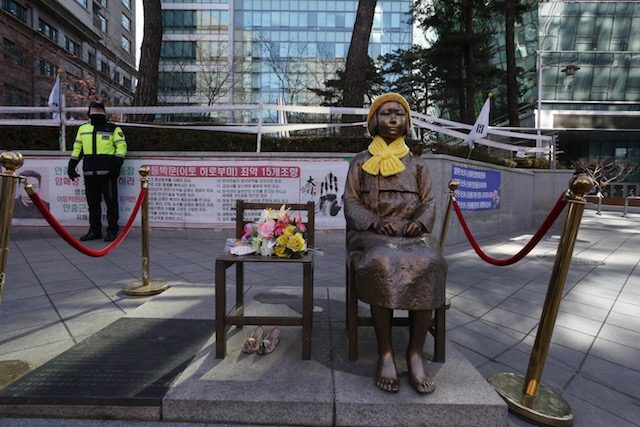SUMMARY
This is AI generated summarization, which may have errors. For context, always refer to the full article.

SEOUL, South Korea – A landmark deal between South Korea and Japan to end a decades-old feud over wartime sex slaves is struggling to overcome a diminutive but daunting obstacle in the form of the small statue of a teenage girl.
“I am here to defend the peace monument,” 22-year-old Jung Woo-Ryung defiantly declared, as she stood guard Tuesday, January 5, beside the seated bronze figure that was erected on the pavement opposite the Japanese embassy in Seoul in 2011.
Depicting a young, barefoot women, dressed in a traditional Korean hanbok dress and with her fists clasped tight in her lap, the statue is both a symbol of the suffering endured by so-called “comfort women” forced to work in Japanese military brothels during World War II, and of their struggle to extract a formal apology and compensation from Tokyo.
Last week, Japan offered an apology and a one-billion yen ($8.3 million) payment to the 46 surviving Korean comfort women under an agreement which both countries described as “final and irreversible”.
But the deal has triggered confusion over the fate of the comfort woman statue, which has now become a focus for South Korean activists who accuse the government of selling out to Tokyo.
A confused deal
Japan insists the agreement included a clear undertaking from South Korea to remove the statue, with Japanese Foreign Minister Fumio Kishida stating Monday, January 4, that he understood it would be “relocated appropriately”.
But Seoul says it only promised to look into the possibility of moving the bronze and called in a senior Japanese embassy official to protest what it called Kishida’s provocative comments.
South Korea’s foreign ministry has also stressed that because the statue was put up by civic groups, it has no right to order its removal.
And the group that spearheaded the campaign to create and erect the bronze is adamant that it isn’t going anywhere.
The statue cannot be “a condition or means of any agreement,” the Korean Council for the Women Drafted for Military Sexual Slavery by Japan said in a statement on its website.
“And the Korean government cannot mention anything about the removal or moving of the monument,” it added.
South Korean public sentiment about the overall agreement is evenly divided, but on the specific issue of the statue passions run high, with surveys showing up to 75% of people opposed to the slightest relocation.
Tricky balancing act
Bong Young-Shik, a senior research fellow specialising in Japan at the Asan Institute for Policy Studies in Seoul, said the row placed the South Korean government in a tight spot, given the substantial political capital it has already expended on making the deal with Japan.
“The issue of the wartime sex slaves is a highly emotive issue in Korea and the statue is its symbol,” Bong told Agence France-Presse.
“The public is infuriated by Japanese attempts to remove the statue, but even more outraged because it looks like the Korean government is collaborating,” he added.
The bronze figure that has stared across the road at the Japanese embassy for the past 4 years was set up with public donations totalling 30 million won ($25,000).
An empty chair next to the young woman represents the victims who have died since the war, while a shadow engraved into the base of the statue is that of a frail old woman – reflecting the agony that still haunts the survivors.
The statue has proved to be an extremely potent and popular symbol, and is regularly wrapped in clothing with the passing seasons – such as a woolly hat and scarf in winter.
More than two dozen similar monuments have been erected around South Korea, and another dozen or so abroad in the United States, Canada and elsewhere.
Outside the Japanese embassy, Jung Woo-Ryung said she would keep guarding the statue as long as necessary.
Jung belongs to a student organisation that is one of a number of groups who have organised a rotating round-the-clock vigil to keep the bronze where it is.
“We are demanding that the issue be resolved by meeting the demands of the victims. I will continue to come here as long as the protest goes on,” she said. – Hwang Sung-Hee, AFP / Rappler.com
Add a comment
How does this make you feel?
There are no comments yet. Add your comment to start the conversation.